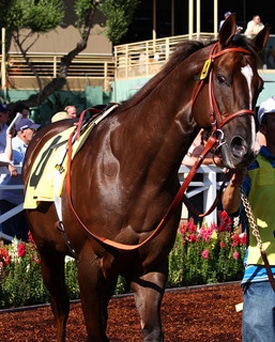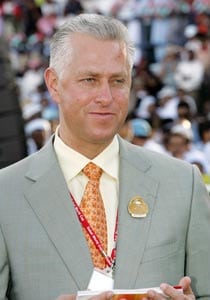Three hundred and sixty-nine horses were confirmed for the 2013 Triple Crown series prior to the Jan. 26 deadline for early nominations. Each horse cost $600 to nominate.
1. How much money was paid altogether by the owners of these early nominees?
This year’s total of early nominees is down from the 398 horses made eligible during the early phase in 2012.

The next stage in the process, the late nomination period, requires the payment of a $6,000 fee with each nominee. This stage ends March 23 at 11:59 p.m. (EST).
3. Write this date using decimal notation.
The Triple Crown starts with the Kentucky Derby on May 4 and is followed on May 18 by the Preakness Stakes. The final leg of the Triple Crown, the Belmont Stakes, in on June 8.
4. How many days are there between the Kentucky Derby and the Preakness Stakes? Give your answer in both days and weeks.
5. How many days are there between the Preakness Stakes and the Belmont Stakes? Give your answer in both days and weeks.

Trainer Todd Pletcher
The trainer with the most horses nominated is Todd Pletcher with 29 nominees.
6. What percentage of the total number of nominated horses is trained by Todd Pletcher?
The overall total of 369 Triple Crown nominees includes 325 colts. Two percent of the nominees are fillies.
7. What percentage of the horses are colts?
8. How many fillies are nominated?
The United States was the birthplace of 352 nominated horses. Of those, 263 were born in Kentucky.
9. What percentage of the horses born in the United States were born in Kentucky?
Seventeen nominees were bred outside of the U.S. borders. 65% of those bred outside the U.S. were bred in Canada.
10. How many of the 17 international nominees were bred in Canada?
The Kentucky Derby field has been limited to 20 starters since 1975 and the horses that enter the starting gate for this year’s running will be determined for the first time by points earned in the new “Road to the Kentucky Derby” eligibility system. The field for the Preakness is limited to 14 starters, while the Belmont Stakes permits a maximum field of 16 horses.
1. How much money was paid altogether by the early nominees?
Answer: 369 x 600 = 221, 400. Altogether, $221,400 was paid.
2. How many fewer horses are nominated at this stage this year?
Answer: 398 – 369 = 29. 29 fewer horses were nominated at this stage.
3. Write this date using decimal notation.
Answer: 2013.03.23
4. How many days are there between the Kentucky Derby and the Preakness Stakes? Give your answer in both days and weeks.
Answer: 18 – 4 = 14. There are 14 days, or two weeks between the first two races.
5. How many days are there between the Preakness Stakes and the Belmont Stakes? Give your answer in both days and weeks.
Answer: Step 1 – find the number of days remaining in May: 31-18 = 13.
Step 2 – Add the number of remaining days in May to the 8 days in June: 13 + 8 = 21.
There are 21 days, or 3 weeks between the final two races in the Triple Crown.
6. What percentage of the total number of nominated horses is trained by Todd Pletcher?
Answer: 29/369 x 100% = 8%
7. What percentage of the horses are colts?
Answer: 325/369 x 100% = 88%
8. How many fillies are nominated?
Answer: 369 x .02 = 7.38. Seven fillies are nominated.
9. What percentage of the horses born in the United States were born in Kentucky?
Answer: 263/352 x 100% = 74.7. 74.7% were born in Kentucky.
10. How many of the 17 international nominees were bred in Canada?
Answer: 17 x .65 = 11.05. Eleven horses were bred in Canada.
Photos:
Churchill Downs by Jeff Kubina; CC BY-SA 2.0
Thor’s Bullet by Rennett Stowe; CC BY 2.0
Tod Pletcher by BANAMINE; CC BY-SA 2.0







